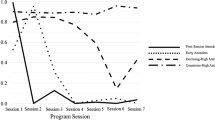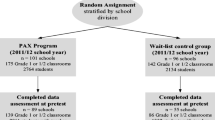Predictors of participation and exposure across two formats of a universal prevention program are examined here. Families of 225 8th-grade students, balanced by race (African American and European American) and gender, were assigned to a parent and adolescent group format (PAG) or a self-administered format (SA). Logistic regression showed greater program initiation in SA than in PAG. Hierarchical regression showed only one variable (parent high-risk behavior) to be associated with lower program exposure in the self-administered format. In contrast, demographic variables (e.g., being African American) predicted lower exposure in PAG. Overall, the findings of this study were notable in that most of the variables that have been identified in past research as lowering participation rates were not related to program initiation or level of exposure to either format of Parents Who Care. Further, the self-administered format may be particularly useful to increase program participation for families, even those who are traditionally difficult to reach.
Editors’ Strategic Implications: The authors make a promising contribution to the literature on program engagement by presenting experimental data highlighting different risk factors for nonparticipation across program formats. Their discussion of barriers will help program designers and practitioners decide on the most appropriate strategies for the dissemination of prevention-related materials to parents.
Similar content being viewed by others
Notes
Due to the high correlation between parent education and family income, we did not include both of the variables in the analyses. We chose to include parent education because past research has shown it to be more consistently related to parent behaviors and attitudes than other socioeconomic variables (Bornstein, Hahn, Suwalsky, & Haynes, 2003).
REFERENCES
Bauman, K. E., Ennett, S. T., Foshee, V. A., Pemberton, M., & Hicks, K. (2001). Correlates of participation in a family-directed tobacco and alcohol prevention program for adolescents. Health Education and Behavior, 28, 440–461.
Bauman, K. E., Ennett, S. T., Foshee, V. A., Pemberton, M., King, T. S., & Koch, G. G. (2000). Influence of a family-directed program on adolescent cigarette and alcohol cessation. Prevention Science, 1, 227–237.
Bauman, K. E., Foshee, V. A., Ennett, S. T., Pemberton, M., Hicks, K. A., King, T. S., et al. (2001). The influence of a family program on adolescent tobacco and alcohol use. American Journal of Public Health, 91, 604–610.
Bornstein, M. H., Hahn, C.-S., Suwalsky, J. T. D., & Haynes, O. (2003). Socioeconomic status, parenting, and child development: The Hollingshead Four-Factor Index of Social Status and The Socioeconomic Index of Occupations. In M. H. Bornstein & R. H. Bradley (Eds.), Socioeconomic status, parenting, and child development. Monographs in parenting series (pp. 29–82). Mahwah, NJ: Lawrence Erlbaum Associates, Publishers.
Catalano, R. F., & Hawkins, J. D. (1996). The social development model: A theory of antisocial behavior. In J. D. Hawkins (Ed.), Delinquency and crime: Current theories (pp. 149–197). New York: Cambridge University Press.
DeMarsh, J., & Kumpfer, K. L. (1985). Family-oriented interventions for the prevention of chemical dependency in children and adolescents. Journal of Children in Contemporary Society, 18, 117–151.
Dumas, J. E. (1986). Parental perception and treatment outcome in families of aggressive children: A causal model. Behavior Therapy, 17, 420–432.
Dumka, L. E., Garza, C. A., Roosa, M. W., & Stoerzinger, H. D. (1997). Recruitment and retention of high-risk families into a preventive parent training intervention. Journal of Primary Prevention, 18, 25–39.
Farrington, D. P., & Welsh, B. C. (1999). Delinquency prevention using family-based interventions. Children and Society, 13, 283–303.
Fischer, J., & Cocoran, K. (1994). Measures for clinical practice. New York: The Free Press.
Forgatch, M. S., & Martinez, C. R., Jr. (1999). Oregon-modellen Teori, behandlingsprogram og implementering i Norge [Parent management training]. Tidsskrift for Norsk Psykologforening, 36, 923–937.
Fraser, M. W., Hawkins, J. D., & Howard, M. O. (1988). Parent training for delinquency prevention. Child and Youth Services, 11, 93–125.
Gainey, R. R., Catalano, R. F., Haggerty, K. P., & Hoppe, M. J. (1995). Participation in a parent training program for methadone clients. Addictive Behavior, 20, 117–125.
Haggerty, K. P., Fleming, C. B., Lonczak, H. S., Oxford, M. L., Harachi, T. W., & Catalano, R. F. (2002). Predictors of participation in parenting workshops. Journal of Primary Prevention, 22, 375–387.
Haggerty, K. P., & Skinner, M. (2005). Home Environment Impressions Inventory technical report. Unpublished manuscript, University of Washington, Seattle.
Hawkins, J. D., Catalano, R. F., Starkman, N., & Ford, P. (1996). Parents Who Care: A step by step guide for families with teens. Seattle, WA: Developmental Research and Programs.
Johnston, L. D., O'Malley, P. M., & Bachman, J. G. (2003). Monitoring the Future national survey results on drug use, 1975–2002. Volume II: College students and adults ages 19–40. (NIH Publication No. 03-5376). Washington, DC: National Institute on Drug Abuse.
Kacir, C. D., & Gordon, D. A. (1999). Parenting adolescents wisely: The effectiveness of an interactive videodisk parent training program in Appalachia. Child and Family Behavior Therapy, 21, 1–22.
Kosterman, R., Hawkins, J. D., Spoth, R., Haggerty, K. P., & Zhu, K. (1997). Effects of a preventive parent-training intervention on observed family interactions: Proximal outcomes from preparing for the Drug Free Years. Journal of Community Psychology, 25, 337–352.
Mason, W. A., Kosterman, R., Hawkins, J. D., Haggerty, K. P., & Spoth, R. L. (2003). Reducing adolescents' growth in substance use and delinquency: Randomized trial effects of a preventive parent-training intervention. Prevention Science, 4, 203–312.
Nordstorm, A., Dumas, J., & Gitter, A. (2003, June). Family level process of engagement and retention: Examining parental attributions, barriers to participation, and family contextual factors. Presented at the Society for prevention Research, Washington, DC.
Offord, D. R. (2000). Selection levels of prevention. Addictive Behaviors, 25, 833–842.
Patterson, G. R. (1996). Some characteristics of a developmental theory for early-onset delinquency. In M. F. Lenzenweger & J. J. Haugaard (Eds.), Frontiers of developmental psychopathology (pp. 81–124). New York: Oxford University Press.
Patterson, G. R., Reid, J. B., & Dishion, T. J. (1992). A social interactional approach: Vol. 4. Antisocial boys. Eugene, OR: Castalia.
Pollard, J. A. (1998). Final report on NIDA SBIR grant #DA07435, Risk Focused Family Training for Drug Use Intervention. Seattle, WA: Developmental Research and Programs.
Ratcliffe, W. D., & Wittman, W. P. (1983). Parenting education: test-market evaluation of a media campaign. Prevention in Human Services, 2, 97–109.
Rohrbach, L. A., Hodgson, C. S., Broder, B. I., Montgomery, S. B., Flay, B. R., Hansen, W. B., et al. (1994). Parental participation in drug abuse prevention: Results from the Midwestern Prevention Project. Journal of Research on Adolescence, 4, 295–317.
Sanders, M. R., Turner, K. M. T., & Markie-Dadds, C. (2002). The development and dissemination of the Triple P-Positive Parenting Program: A multilevel, evidence-based system of parenting and family support. Prevention Science, 3, 173–189.
Spoth, R., & Molgaard, C. (1993). Consumer-focused data collection in prevention program evaluation: Rationale and illustrations. Evaluation and the Health Professions, 16, 278–294.
Spoth, R., & Redmond, C. (1993). Identifying program preferences through conjoint analysis: Illustrative results from a parent sample. American Journal of Health Promotion, 8, 124–133.
Spoth, R., & Redmond, C. (2000). Research on family engagement in preventive interventions: Toward improved use of scientific findings in primary prevention practice. Journal of Primary Prevention, 21, 267–284.
Spoth, R., Redmond, C., Haggerty, K., & Ward, T. (1995). A controlled parenting skills outcome study examining individual difference and attendance effects. Journal of Marriage and the Family, 57, 449–464.
Spoth, R., Redmond, C., Hockaday, C., & Shin, C. Y. (1996). Barriers to participation in family skills preventive interventions and their evaluations: A replication and extension. Family Relations: Journal of Applied Family and Child Studies, 45, 247–254.
Spoth, R. L., & Conroy, S. M. (1993). Survey of prevention-relevant beliefs and efforts to enhance parenting skills among rural parents. The Journal of Rural Health, 9, 227–239.
Spoth, R. L., Guyll, M., & Day, S. X. (2002). Universal family-focused interventions in alcohol-use disorder prevention: Cost-effectiveness and cost-benefit analyses of two interventions. Journal of Studies on Alcohol, 63, 219–228.
Spoth, R. L., Redmond, C., & Shin, C. (2001). Randomized trial of brief family interventions for general populations: Adolescent substance use outcomes 4 years following baseline. Journal of Consulting and Clinical Psychology, 69, 627–642.
Wahler, R. G. (1980). The insular mother: Her problems in parent-child treatment. Journal of Applied Behavior Analysis, 13, 207–219.
Wahler, R. G., Leske, G., & Rogers, E. S. (1979). The insular family: A deviance support system for oppositional children. In L. A. Hamerlynck (Ed.), Behavioral systems for the developmentally disabled: I. School and family environments (pp. 102–127). New York: Brunner/Mazel.
Webster-Stratton, C., & Taylor, T. (2001). Nipping early risk factors in the bud: Preventing substance abuse, delinquency, and violence in adolescence through interventions targeted at young children (0 to 8 Years). Prevention Science, 2, 165–192.
ACKNOWLEDGMENTS
This paper was supported by Grant # R01-DA121645 from the National Institute on Drug Abuse. We wish to thank Susan Smith and Charles B. Fleming for their assistance with an earlier version of this manuscript.
Author information
Authors and Affiliations
Corresponding author
Rights and permissions
About this article
Cite this article
Haggerty, K.P., MacKenzie, E.P., Skinner, M.L. et al. Participation in “Parents Who Care”: Predicting Program Initiation and Exposure in Two Different Program Formats. J Primary Prevent 27, 47–65 (2006). https://doi.org/10.1007/s10935-005-0019-3
Published:
Issue Date:
DOI: https://doi.org/10.1007/s10935-005-0019-3




